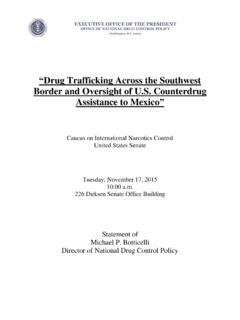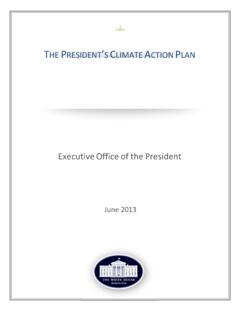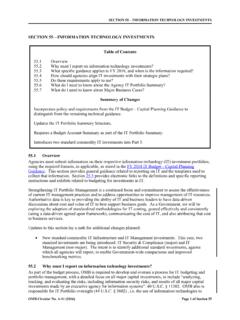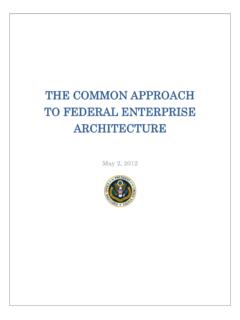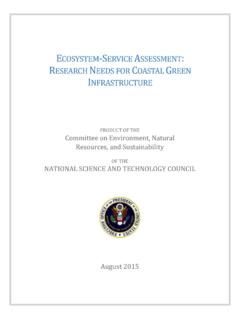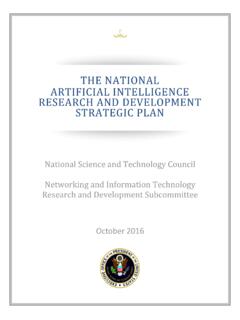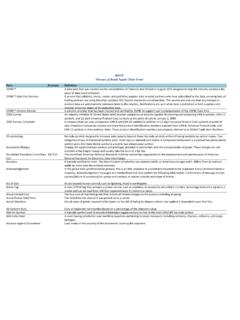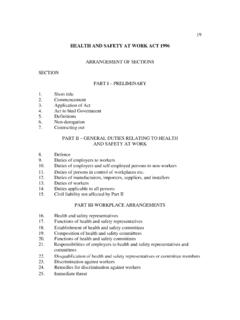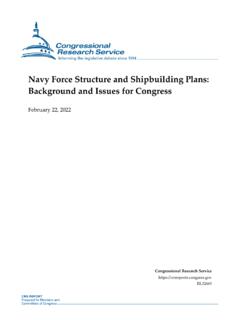Transcription of THE NATIONAL SECURITY IMPLICATIONS OF A CHANGING …
1 Findings from Select Federal Reports: THE NATIONAL SECURITY . IMPLICATIONS OF. A CHANGING CLIMATE. May 2015. Climate change is an urgent and growing threat to our NATIONAL SECURITY , contributing to increased natural disasters, refugee flows, and conflicts over basic resources like food and water. The present day effects of climate change are being felt from the Arctic to the Midwest. Increased sea levels and storm surges threaten coastal regions, infrastructure, and property. In turn, the global economy suffers, compounding the growing costs of preparing and restoring infrastructure.. - White House, NATIONAL SECURITY Strategy, February 2015. The impacts of climate change could directly affect the Nation's critical infrastructure. In coastal regions, rising sea levels, higher storm surge, and increased erosion could damage or destroy critical infrastructure.
2 In Western States, higher temperatures and more frequent or severe heat waves could buckle railways, damage roads, and strain power systems.. - Department of Homeland SECURITY , Climate Change Adaptation Roadmap, June 2012. We judge global climate change will have wide-ranging IMPLICATIONS for NATIONAL SECURITY interests over the next 20 years .. The United States depends on a smooth-functioning international system ensuring the flow of trade and market access to critical raw materials such as oil and gas, and SECURITY for its allies and partners. Climate change and climate change policies could affect all of these domestic stability in a number of key states, the opening of new sea lanes and access to raw materials, and the global economy more broadly with significant geopolitical consequences.
3 - NATIONAL Intelligence Committee, NATIONAL Intelligence assessment on the NATIONAL SECURITY IMPLICATIONS of Global Climate Change to 2030, June 25, 2008. A CHANGING climate will have real impacts on our military and the way it executes its missions. The military could be called upon more often to support civil authorities, and provide humanitarian assistance and disaster relief in the face of more frequent and more intense natural disasters. Our coastal installations are vulnerable to rising sea levels and increased flooding, while droughts, wildfires, and more extreme temperatures could threaten many of our training activities. Our supply chains could be impacted, and we will need to ensure our critical equipment works under more extreme weather conditions.
4 Weather has always affected military operations, and as the climate changes, the way we execute operations may be altered or constrained .. Climate change will affect the Department of Defense's ability to defend the Nation and poses immediate risks to NATIONAL SECURITY .. - Department of Defense, Climate Change Adaptation Roadmap, 2014. 2 . Overview The effects of climate change are already being felt across many parts of the world, increasingly posing new risks to America's NATIONAL SECURITY both domestically and internationally. This document draws from some of the reports published by the Federal government addressing the NATIONAL SECURITY IMPLICATIONS of climate change. These analytical and strategic documents, including the Third NATIONAL Climate assessment , the White House's 2015 NATIONAL SECURITY Strategy, the Department of Defense's 2014 Quadrennial Defense Review, and the Department of Homeland SECURITY 's 2014 Quadrennial Homeland SECURITY Review, provide critical insight both in terms of the nature of the threat and the way the Federal government is rising to the challenge.
5 * * *. With climate change, certain types of extreme weather events and their impacts, including extreme heat, heavy downpours, floods, and droughts, have become more frequent and/or intense. In addition, warming is causing sea level to rise and glaciers and Arctic sea ice to melt. These and other aspects of climate change are disrupting people's lives and damaging certain sectors of the economy. The NATIONAL SECURITY IMPLICATIONS of climate change impacts are far- reaching, as they may exacerbate existing stressors, contributing to poverty, environmental degradation, and political instability, providing enabling environments for terrorist activity abroad. For example, the impacts of climate change on key economic sectors, such as agriculture and water, can have profound effects on food SECURITY , posing threats to overall stability.
6 The IMPLICATIONS of climate change on NATIONAL SECURITY are not all beyond borders they pose risks here at home. According to the Third NATIONAL Climate assessment , sea level rise, coupled with storm surge, will continue to increase the risk of major coastal impacts on transportation infrastructure, including both temporary and permanent flooding of airports, ports and harbors, roads, rail lines, tunnels, and bridges. Extreme weather events are also affecting energy production and delivery facilities, causing supply disruptions of varying lengths and magnitudes and affecting other infrastructure that depends on energy supply. Increasing risk of flooding affects human safety and health, property, infrastructure, economies, and ecology in many basins across the United States.
7 These impacts increase the frequency, scale, and complexity of future defense missions, requiring higher costs of military base maintenance and impacting the effectiveness of troops and equipment in conflict. Assessments are currently underway by the Department of Defense (DOD) to determine the NATIONAL resources necessary to respond to these growing threats to NATIONAL SECURITY . * * *. 3 . SECURITY IMPLICATIONS Domestic Federal literature outlining the domestic SECURITY IMPLICATIONS of climate change ranges from treatment of specific regional impacts such as along coastal areas or in the Arctic to a broader look at domestic risks. The NATIONAL SECURITY IMPLICATIONS of climate change are not isolated to any one region, and the impacts will be felt in different ways.
8 Coastal Areas at Risk For a fuller discussion on coastal areas at risk due to climate change, see the Department of Homeland SECURITY 's Climate Action Plan from 2013. coastal areas are on the frontlines of the threat posed by CHANGING climate. Critical infrastructure, major military installations, and hurricane evacuation routes are increasingly vulnerable to impacts, such as higher sea levels, storm surges, and flooding exacerbated by Projected sea level rise and flooding in the coastal United States by 2050. Melillo, Jerry, Terese Richmond, and Gary W. Yohe, Climate Change Impacts in the United States: The Third NATIONAL Climate assessment , Global Change Research Program, 2014. climate change. Sea level rise, coupled with storm surge, will continue to increase the risk of major coastal impacts on transportation infrastructure, including both temporary and permanent flooding of airports, ports and harbors, roads, rail lines, tunnels, and bridges.
9 4 . Superstorm Sandy provides a powerful example, as the storm's effects were exacerbated by the sea level in the New York Harbor, which had risen one foot since 1900. The storm had devastating impacts on the northeastern seaboard, impacting critical infrastructure. Hospitals were evacuated and train and roadway tunnels and waste water treatment facilities were flooded. All told, the storm left million people without power and caused tens of billions of dollars in damages. Marines and sailors assigned to the 26th Marine Expeditionary Unit step off a landing craft utility vehicle onto the shore of Breezy Point, New York, on Nov. 9, 2012. They and troops from other units partnered with the Federal Emergency Management Agency, the Army Corps of Engineers and the NATIONAL Guard after Hurricane Sandy.
10 Marine Corps photo. The Federal response to Hurricane Sandy illustrated the breadth and depth of response necessary from SECURITY personnel in the wake of extreme events. From first-responders and the Federal Emergency Management Agency to the NATIONAL Guard and Coast Guard, the response came from all quarters. This included DOD, which increased the capacity of the Joint Logistics Operations Center by instituting around-the-clock shifts, helping to coordinate the delivery of million meals, million gallons of fuel, and other medical and staple necessities. DOD also delivered generators and high-capacity pumps to ease the burden of power outages and dry out water-damaged buildings and key structures. Strategic response extends beyond the immediate aftermath of a storm.
